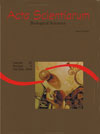<b>Indolacetic acid production by P-solubilizing microorganisms and interaction with arbuscular mycorrhizal fungi</b> - DOI: 10.4025/actascibiolsci.v29i3.492
Abstract
Indolacetic acid (IAA) production was evaluated under in vitro conditions by five P-solubilizing fungi (PSF), identified as Aspergillus sp. and four P-solubilizing bacteria (PSB) of the Enterobacteriaceae family. The bacteria and fungus isolates were incubated in a liquid medium at 28ºC for two and four days, respectively. Moreover, two PSB isolates of the Enterobacteriaceae family (PSB 8 and PSB 56) were evaluated in relation to their ability to stimulate or inhibit spore germination and hyphal growth of two arbuscular mycorrhizal fungi (AMF) species under in vitro conditions. Two assays were carried out in Petri dishes with agar (0.8%), the first using the AMF Gigaspora margarita and the second with the AMF Scutellospora sp. The treatments were: inoculation of PSB 8; PSB 56 and uninoculated control. P-solubilizing isolates produced different amounts of IAA and most PSF isolates produced higher IAA than PSB. From the 18th day of incubation of Scutellospora sp., a significant increase in hyphal growth in the treatment inoculated with PSB 8 was observed. In contrast, PSB 56 inhibited the hyphal growth of Gigaspora margarita from the 24th day of incubation.Downloads
Download data is not yet available.
Published
2007-12-05
How to Cite
Souchie, E. L., Azcón, R., Barea, J. M., Saggin-Júnior, O. J., & Silva, E. M. R. da. (2007). <b>Indolacetic acid production by P-solubilizing microorganisms and interaction with arbuscular mycorrhizal fungi</b> - DOI: 10.4025/actascibiolsci.v29i3.492. Acta Scientiarum. Biological Sciences, 29(3), 315-320. https://doi.org/10.4025/actascibiolsci.v29i3.492
Issue
Section
Microbiology
DECLARATION OF ORIGINALITY AND COPYRIGHTS
I Declare that current article is original and has not been submitted for publication, in part or in whole, to any other national or international journal.
The copyrights belong exclusively to the authors. Published content is licensed under Creative Commons Attribution 4.0 (CC BY 4.0) guidelines, which allows sharing (copy and distribution of the material in any medium or format) and adaptation (remix, transform, and build upon the material) for any purpose, even commercially, under the terms of attribution.
Read this link for further information on how to use CC BY 4.0 properly.
0.6
2019CiteScore
31st percentile
Powered by 

0.6
2019CiteScore
31st percentile
Powered by 











1.png)




3.png)













